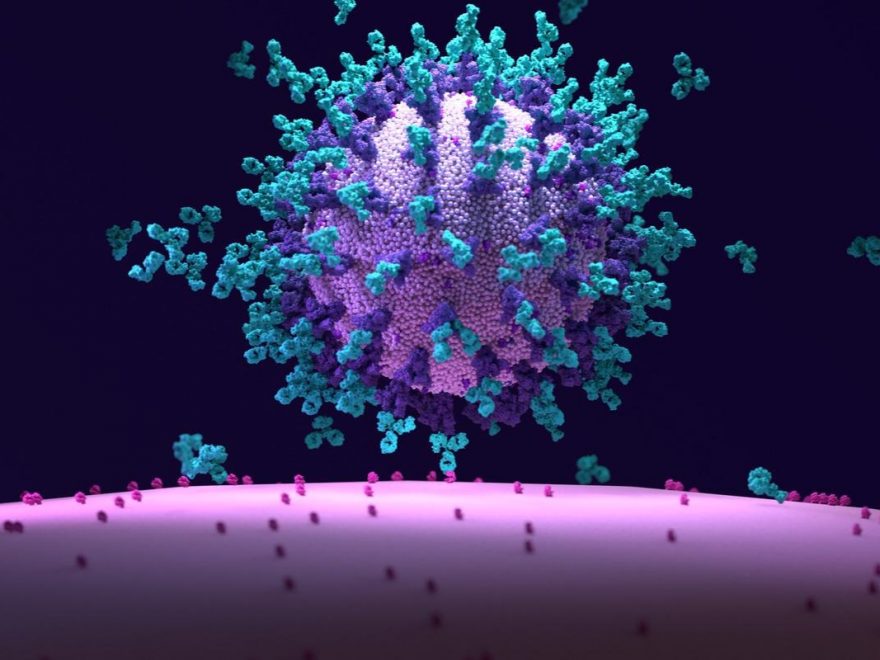In a recent study posted to the bioRxiv* preprint server, researchers evaluated the neutralizing antibody titers in mice vaccinated with messenger ribonucleic acid (mRNA) encoding severe acute respiratory syndrome coronavirus 2 (SARS-CoV-2) spike (S) protein.
 Study: Vaccine-elicited murine antibody WS6 neutralizes diverse beta-coronaviruses by recognizing a helical stem supersite of vulnerability. Image Credit: Design_Cells/Shutterstock
Study: Vaccine-elicited murine antibody WS6 neutralizes diverse beta-coronaviruses by recognizing a helical stem supersite of vulnerability. Image Credit: Design_Cells/Shutterstock
Various beta-coronaviruses (beta-CoVs)-associated zoonotic infections, such as the Middle East respiratory syndrome (MERS), severe acute respiratory syndrome (SARS), and the ongoing coronavirus disease 2019 (COVID-19), have caused several pandemics and epidemics in recent years. Currently, approved COVID-19 vaccinations are becoming less effective due to their waning effect and the emergence of heavily mutated SARS-CoV-2 variants like Delta and Omicron.
Moreover, there is a potential threat of more betaCoVs-associated zoonotic infections in the future. Thus, universal vaccines and broadly neutralizing antibodies against a wide range of betaCoVs are required to mitigate pandemics such as the COVID-19 pandemic, especially as the SARS-CoV-2 Omicron variant evades natural and vaccine-induced immunity.
About the study
In the present study, the researchers analyzed the extent of neutralizing capacity of antibodies from SARS-CoV-2 S mRNA-immunized mice by evaluating the murine antibody's epitope location, the magnitude of binding, and neutralization among diverse beta-CoV's S.
By intramuscular immunization of mice with SARS-CoV-2 wildtype (WT) WA-1 variant S-encoding messenger ribonucleic acid (mRNA), SARS-CoV-2 S-specific antibodies were obtained. The antibodies bound to SARS-CoV-2 S-dTM, soluble S residues 1-1206 of WT WA-1 strain, were identified using enzyme-linked immunosorbent assay (ELISA). SARS-CoV-2-antibodies’ binding breadth was determined by assessing WS1-11 recognition on a panel of prefusion-stabilized diverse beta-coronavirus spikes (S2Ps).
WS6's broad reactivity towards S2Ps of WIV1, hCoV-OC43, hCoV-229E, SHC014, and RaTG13, was also determined using ELISAs. Further, WS6 binding affinity towards betaCoV S2Ps and cell surface expressing the Ss of MERS-CoV, SARS-CoV, SARS-CoV-2, hCoV-OC43, and hCoV-HKU1 was determined using biolayer interferometry (BLI) and flow cytometry, respectively.
The broad betaCoVs neutralization of WS6 was determined using pseudovirus neutralization assays. The epitope mapping of WS6 was conducted using negative strain-electron microscopy (EM) and peptide array-based epitope mapping. The WS6 in complex with peptides based on SARS-CoV-2 S sequences' crystal structure was analyzed at 2 Å of the antigen-binding fragment (Fab) to determine the mechanism associated with the broad reactivity of WS6 among betaCoVs.
Findings
The results indicated that 11 antibodies, including WS1 to WS11, bound SARS-CoV-2 S-dTM following SARS-CoV-2 S mRNA immunizations in mice. Of the 11 antibodies, nine bound with the SARS-CoV-2 S1 region, six with the N-terminal domain (NTD), and three with the receptor-binding domain (RBD). The WS5 and WS6 did not bind SARS-CoV-2 S1, NTD, or RBD.
Further, WS5 and WS6 showed a 10-fold reduction in binding towards SARS-CoV-2 compared to other immunogens, such as SARS-CoV, hCoV-HKU1, and MERS-CoV, whereas WS7, WS4, and WS3 had 1000 times lower affinity towards SARS-CoV-2. WS6 neutralized both SARS-CoV and SARS-CoV-2, whereas WS5 did not neutralize either of them.
The WS6 antibody neutralized all SARS-CoV, SARS-CoV-2 variants such as Omicron and Delta, and other related sarbecoviruses tested, except hCoV-229E. During the epitope mapping and crystal structure analysis, WS6-S2 stem-helix epitope peptide crystal structure appeared conserved between MERS-CoV, hCoV-OC43, and SARS-CoV-2. The structural and neutralization analyses revealed that WS6 neutralized SARS-CoV-2 S by inhibiting its perfusion and post-viral attachment. To demonstrate the mechanism of neutralization of beta-coronaviruses by WS6, BHK21-ACE2 cells were incubated with SARS-CoV-2 S pseudotyped lentivirus on ice that allowed the virus to attach to angiotensin-converting enzyme 2 (ACE2).
After thorough washing, cells were again incubated with WS6 or WS4 on ice for one hour and at 37OC for 72 hours. RBD-directed WS4 neutralizing antibody neutralized not more than 40% of the virus, whereas WS6 seamlessly neutralized the ACE2 pre-attached virus.
A promising target for vaccine design, vulnerable stem-helical supersite on SARS-CoV-2 spanning over hydrophobic residues Tyr1155, Leu1152, Phe1156, and Phe1148, was identified in WS6 and other S-targeted antibodies such as IgG22, and B6 from SARS-CoV-2 S immunized mice, and CV3-25, CC40.8, and S2P6 from SARS-CoV-2-infected convalescent individuals.
The comparison of WS6 and S2P6 neutralization of various CoVs, including SARS-CoV-2, revealed that S2P6 did not neutralize the SARS-CoV-2 Omicron variant, whereas WS6 neutralized Omicron. Further, WS6 exhibited a more potent neutralization against all tested SARS-CoV-2 strains than S2P6, whereas WS6 was non-neutralizing against MERS-CoV.
The murine antibodies IgG22 and B6 recognized SARS-CoV-2 S almost similarly, given both were generated after MERS-CoV and SARS-CoV-2 S immunization, and utilized the VH1-19, heavy chain origin gene. In contrast, WS6 was generated only after the SARS-CoV-2 S immunization and did not utilize the same V-gene as the IgG22 and B6 antibodies.
Conclusions
In the current study, the researchers identified WS6, an S2-targeted antibody, from a mouse immunized with SARS-CoV-2 S encoded mRNA. WS6 neutralized all SARS-CoV-2 variants, including Omicron, and several other humans and animal-related sarbecoviruses analyzed in the study.
Most importantly, a highly promising vaccine target, a hydrophobic cluster spanning three helical turns with its center turn framed by acidic residues, was identified in the S2 subunit region of WS6. Comparison between recently identified S2-directed antibodies and WS6 identified a novel murine S2-helix recognition mode, and immunization with MERS-CoV S was not required to induce S2-targeted antibodies.
However, further studies are required to determine 1) whether S2-helix peptide-based immunizations can generate broadly neutralizing serological immune responses; 2) immune responses associated with nanoparticles loaded with S-2 helix; 3) S2-helix focused immunization-driven broad and potent immune responses against future SARS-CoV-2 strains or potential betaCoV zoonotic crossovers; and 4) the impact of S2-targeted immunizations in conjunction with current licensed S-based vaccines like Johnson and Johnson, Moderna, and Pfizer in generating immune responses.
*Important notice
bioRxiv publishes preliminary scientific reports that are not peer-reviewed and, therefore, should not be regarded as conclusive, guide clinical practice/health-related behavior, or treated as established information.
- Wei Shi, et al. (2022). Vaccine-elicited murine antibody WS6 neutralizes diverse beta-coronaviruses by recognizing a helical stem supersite of vulnerability. bioRxiv. doi: https://doi.org/10.1101/2022.01.25.477770 https://www.biorxiv.org/content/10.1101/2022.01.25.477770v1
Posted in: Medical Science News | Medical Research News | Disease/Infection News
Tags: ACE2, Angiotensin, Angiotensin-Converting Enzyme 2, Antibodies, Antibody, Antigen, Assay, binding affinity, Cell, Coronavirus, Coronavirus Disease COVID-19, covid-19, Cytometry, Electron, Electron Microscopy, Enzyme, Flow Cytometry, Gene, Helix, immunity, Immunization, Lentivirus, MERS-CoV, Microscopy, Nanoparticles, Omicron, Pandemic, Peptides, Protein, Pseudovirus, Receptor, Respiratory, Ribonucleic Acid, SARS, SARS-CoV-2, Severe Acute Respiratory, Severe Acute Respiratory Syndrome, Syndrome, Vaccine, Virus

Written by
Shanet Susan Alex
Shanet Susan Alex, a medical writer, based in Kerala, India, is a Doctor of Pharmacy graduate from Kerala University of Health Sciences. Her academic background is in clinical pharmacy and research, and she is passionate about medical writing. Shanet has published papers in the International Journal of Medical Science and Current Research (IJMSCR), the International Journal of Pharmacy (IJP), and the International Journal of Medical Science and Applied Research (IJMSAR). Apart from work, she enjoys listening to music and watching movies.
Source: Read Full Article
